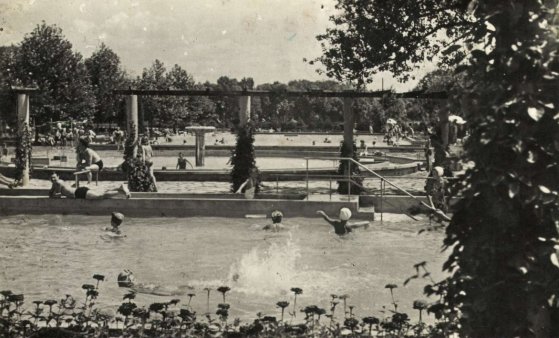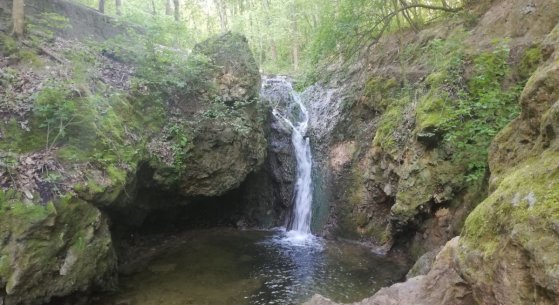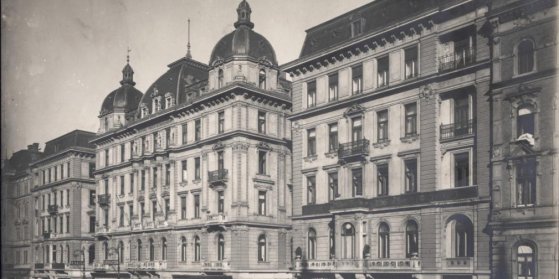 The „intertwined history” of the bridges and the city of Budapest
Which ideas and events have shaped the fate of bridges of Budapest and the cityscape? Alongside many other interesting facts, this question is also answered this newly published book by the Budapest City Archives, which introduces the history of bridges in Budapest.
The „intertwined history” of the bridges and the city of Budapest
Which ideas and events have shaped the fate of bridges of Budapest and the cityscape? Alongside many other interesting facts, this question is also answered this newly published book by the Budapest City Archives, which introduces the history of bridges in Budapest.
PestBuda
 A place of worship in a cave – Cave Church turns 90
A place of worship in a cave – Cave Church turns 90
May 24, 2021 at 2:00 PM
One might think that the Cave Church on the side of Gellért Hill is an old church, although it is surprisingly young, not a hundred years old, as construction of the chapel itself began in 1924 and it was consecrated in 1931. During the communist era, a reinforced concrete wall closed it off from worshippers, which was only demolished in 1992.
Medicinal water was found on Whitsun in the area of today's Pünkösdfürdő Bath
May 24, 2021 at 9:00 AM
The story is almost like a fairy tale because from the moment Sándor Ember, a legal adviser, and later Member of Parliament accidentally learned about the intention to parcel the area near Békásmegyer during a rowing tour on the Danube and bought the land after a quick decision, it was as if everything turned into gold. It soon became clear that the area had unparalleled archaeological finds across Europe and then on Whitsun in 1934, medicinal water was found on the plot, where soon, in the summer of 1935, a bath now known as Pünkösdfürdő ('Whitsun Bath') opened.
Stone column of every station standing on Golgotha Square
May 23, 2021 at 6:00 PM
Fourteen stone statues have already been erected on Golgota Square in Józsefváros. Bronze reliefs depicting the stations of the cross have been placed within them. The restoration of the stations was initiated by the Józsefváros Local Council in 2019 and is being carried out with state funding.
Lutheran church on Deák Square named National Memorial Site
May 22, 2021 at 5:30 PM
The Insula Lutherana in Budapest that is the building complex of the Lutheran church, grammar school and museum on Deák Square has been named a National Memorial Site. Supported by the government, the National Memorial and Remembrance Committee and the Institute of National Heritage, the site was listed as a memorial on 22 May 2021.
Two beautiful gorges on the border of Budapest
May 22, 2021 at 10:00 AM
Places of special beauty can be found everywhere. This time Pestbuda guides its readers to the outskirts of the capital, but that does not detract from their value. The Remete Gorge ('Hermit Gorge') and the Alsó-Jegenye Valley ('Lower Jegenye Valley') attract hundreds and thousands of people on more pleasant weekends. The tour with many attractions can be completed comfortably in a day.
Main building of the Central Bank of Hungary under renovation
May 21, 2021 at 5:30 PM
On the centenary of the founding of the central bank in 2024, the headquarters of the institution will be renovated to their original form on Szabadság Square. The building was built in 1905, its external appearance has not changed since then, but its interiors were significantly remodelled after World War II, undermining its historical value. Now its original beauty will return, inside and out.
The charming boathouses of Római-part have disappeared
May 21, 2021 at 9:00 AM
The Római-part (Roman Beach) was already a popular resting place on the Danube in the 1900s, and it became really popular in the 1920s. The former boathouses tell us about our architectural, sports and cultural-historical values – today mostly only from photographs.
Renovation of Csepel suburban railway to begin in two years
May 20, 2021 at 5:00 PM
The suburban railway line to Csepel will be extended in both directions, and the work will be carried out in several stages. In the first phase – from 2023 – a new terminal will be built in the 21st District on Erdősor Street, in parallel with the modernization of the line from the Kvassay Bridge outwards. In the second phase, the line will be connected to the Ráckeve line at the Public Slaughterhouse and extended underground to Kálvin Square. Implementation of the second phase will begin in 2024 at the soonest.
Remains of Hadrian's palace on Hajógyári Island were found 170 years ago
May 20, 2021 at 10:00 AM
Hadrian was one of the most successful emperors of the Roman Empire. Once, he was the governor of the province of Pannonia. His governor's palace, built in the 2nd century, was in the settlement of Aquincum. The remains of the former huge building were discovered 170 years ago when the Óbuda shipyard expanded its site. The ruins have since been excavated several times on today's Hajógyári (Shipyard) Island.
Winter sports season to be extended on Normafa
May 19, 2021 at 4:00 PM
The 12th District local council has begun preparing the snow cannon investment planned for Normafa. As part of the works, pipes are being laid in the ground, to which the cannons will be connected in the winter. Once completed, lovers of winter sports will be able to use the area for over 3 months each year.
MOME campus development wins international award
May 18, 2021 at 2:00 PM
The MOME Campus building complex has won an award in one of the most prestigious design competitions in the world – the University has announced on its website. The competition awarded works that are characterised by technological innovation, ingenuity and outstanding design.
The Károlyi Palace hosted the country's first large-scale exhibition of applied arts
May 18, 2021 at 9:00 AM
Donations were raised in several places throughout the country to alleviate the damage caused by the floods of February 145 years ago and to help the flood victims. Related to these efforts was the exhibition of applied arts presenting the unique treasures of art, which was organised not in a public collection, but in the palace of Count, Alajos Károlyi built behind the National Museum in May 1876.
New trams heading for Budapest
May 17, 2021 at 6:00 PM
The Budapest Transport Center (BKK) has agreed with the manufacturer of CAF trams. Until mid-May 2022, BKK will be able to call the 51 optional vehicles included in the 2014 contract at the original price.
Most modern boat of the Austro–Hungarian Navy launched 150 years ago
May 17, 2021 at 2:00 PM
The Lajta monitor, one of the most modern warships of its time, was launched 150 years ago, on 17 May 1871. The surviving river boar of the former Austro-Hungarian Navy is now a museum. Its special feature is that the Lajta monitor is the only one in the world from the monitor type river version.
Food kitchens alleviated the misery of the war in Budapest 105 years ago
May 17, 2021 at 9:00 AM
Although World War I did not directly affect the home front, Budapest was not bombed by the enemy like in World War II, but because of the battles, the capital was struggling. In 1916, the state wanted to help. Food kitchens were set up to deliver vegetable dishes and pasta to the poorer quarters of Budapest.
Coins and metal works from the Hungarian conquest of the Carpathian Basin found on construction site
May 15, 2021 at 4:00 PM
An excavation is taking place in the 11th District on Rupp Hill. Archaeologists are reviewing the area before construction. Although the site is mainly Roman, valuable objects from other eras have been found; such as medieval coins, metal works from the Hungarian conquest of the Carpathian Basin and the foundations of a building from the 2nd or 3rd century.
A Tuscan cast many iconic sculptures in Budapest
May 15, 2021 at 11:00 AM
Many foreign masters made a significant contribution to the development of Budapest city. Professionals from German-speaking countries excelled in the fields of architecture and applied arts in particular. A somewhat forgotten master who chose the Hungarian capital as his homeland instead of sunny Tuscany is worth noting. Raffaelo Vignali, or Rafael Vignáli in Hungarian, came to Budapest for the works of the Millennium Monument.
Café open in Guard House in Royal Palace of Buda Castle
May 14, 2021 at 3:30 PM
The Guard House (Főőrség) building opened on Friday. Visitors are invited to the cafe and an exhibition of the 260-year history of the Hungarian Royal Guards. The building designed by Alajos Hauszmann and built in 1903 originally served as the headquarters of the Palace and Royal Guards.
Construction of blue Metro Line M3 began 50 years ago
May 13, 2021 at 9:00 AM
The development of the Budapest underground network entered a new phase 50 years ago when the construction of the city’s third metro line began. Although the ideas changed a lot and the work planned for 15 years took 20, today’s Metro Line 3 is one of Budapest's most important transport corridors.
Divers to search riverbed near Chain Bridge for bombs and wrecks
May 12, 2021 at 6:00 PM
In connection with the renovation of the Chain Bridge, the Danube riverbed around the bridge will be cleaned. During the work, which is expected to take a month and a half, the river will be surveyed with sonar and divers in the 50-meter vicinity of the bridge. Any unspent ammunition found will be disarmed and pieces of metal removed.
Tündérbérc to house children's camp again
May 12, 2021 at 9:00 AM
The name of Csillebérc is still associated with the former pioneer camp and the children's railway. Children spent their holidays in the camp known as Pioneer Republic, and later Csillebérc Pioneer Camp, from 1948. Eventually, a lawsuit that lasted 15 years from the 2000s settled the ownership of the area. Soon, a children's camp will open on Csillebérc again.
The Royal Hotel hosted the first film screening in Hungary 125 years ago
May 11, 2021 at 9:00 AM
Fortunately, the Hungarian Academy of Sciences set the date of the Hungarian conquest of the Carpathian Basin as 896, rather than the originally planned 895. In 1896, the official national millennium was celebrated with miracles such as the first domestic film screenings. The general public could see the screenings in two places: that of the Lumière brothers were held at the Royal Hotel, and Edison’s were shown in Lágymányos.
Szinyei Merse Pál Grammar School renovated
May 10, 2021 at 6:00 PM
Next year Szinyei Merse Pál Secondary School will celebrate its 125th anniversary. Plans are for the renovation of its facade to be completed by then. Standing on Szinyei and Kmety Street, the building designed by Ármin Hegedűs was completed in 1897.
Neo-Gothic wonder on Üllői Road – Church in Ferencváros designed by Sándor Aigner
May 10, 2021 at 9:00 AM
A large number of architects played a huge role in making Budapest a metropolis. They created numerous beautiful plans between the 1870s and 1910s. Many of our public buildings and dwellings that still stand are the fruits of their work. While this view is generally accepted, the names of several masters have almost been forgotten. Such is the case of Sándor Aigner, who designed many churches as a master of Gothic Revival architecture. His most important work is the Perpetual Adoration Church in Ferencváros.
Running track added to Rózsakert Sport Centre
May 9, 2021 at 4:00 PM
A sport-focused development in Budafok-Tétény has been completed. A running track has been added to the Rózsakerti Sports Centre and an ice skating tent is also being set up.
Lake Naplás is true to its name – A place for relaxation
May 9, 2021 at 9:00 AM
The largest still water in Budapest is quite young. It was formed in 1978 during the flood protection regulation of the Szilas stream. Lake Naplás is worthy of its name, as naplás is an abbreviated form of the word napolás (to postpone), and it is worth postponing our other activities to explore the 16-hectare area and its surroundings.
Community area completed along Rákos stream
May 8, 2021 at 3:00 PM
Soon the public will be able to visit the new rest area created on the banks of the Rákos stream. On the southern side of the pedestrian bridge between Hajdú Street and Hajdú Alley in 13th District has been made more comfortable with a less steep incline and a waterfront pier.
Reconstruction of Normafa car park begins – New greens to replace asphalt
May 7, 2021 at 4:00 PM
On 10 May, one of the most important elements of the renewal of Normafa, the elimination of the old bus stop and car park, will begin writes the website of the 12 District local council. What is now an asphalt area in a protected forest will become a green community area. A car park has been created on Konkoly-Thege Road.
Facade of southern connecting wing restored according to original plans – Royal Palace of Buda stands in its original splendour
May 7, 2021 at 2:00 PM
During the reconstruction of the Buda Castle, the original, turn-of-the-century condition of the southern connecting wing has been restored. Várkapitányság has announced, the southern facade of the building was rebuilt according to the original plans, as has the northern facade facing the Lion's Court. After the restoration of the internal spaces, the interior design of Saint Stephen's Hall also started a few weeks ago.
Shortest suburban railway line in Budapest turns 70
May 7, 2021 at 10:00 AM
Suburban railway lines (HÉV - helyiérdekű vasút) have been running from Boráros Square to the 21st District for seventy years. Csepel had a rapid transit connection before, with trains running on Gubacsi Bridge. The suburban railway line to Csepel is record-breaking in many aspects: it is the shortest line, the site of the most serious accident, and currently home to the oldest trains.
More articles
 The „intertwined history” of the bridges and the city of Budapest
Which ideas and events have shaped the fate of bridges of Budapest and the cityscape? Alongside many other interesting facts, this question is also answered this newly published book by the Budapest City Archives, which introduces the history of bridges in Budapest.
The „intertwined history” of the bridges and the city of Budapest
Which ideas and events have shaped the fate of bridges of Budapest and the cityscape? Alongside many other interesting facts, this question is also answered this newly published book by the Budapest City Archives, which introduces the history of bridges in Budapest.
 The Bridge Report, which brought a turning point in the history of Budapest
A travel report that changed the history of Pest and Buda, as well as Hungary. The little book contributed to the change of half a thousand years of legal customs and the implementation of an investment of unprecedented size and technical quality. This book was The Bridge Report [Hídjelentés in Hungarian].
The Bridge Report, which brought a turning point in the history of Budapest
A travel report that changed the history of Pest and Buda, as well as Hungary. The little book contributed to the change of half a thousand years of legal customs and the implementation of an investment of unprecedented size and technical quality. This book was The Bridge Report [Hídjelentés in Hungarian].
 Drama on the university wall - The heroic monument was planned 95 years ago
In the constant hustle and bustle of the Egyetem Square in Pest, the students may not even notice the monument that decorates the short section of wall between the church and the central building of ELTE. However, it commemorates their predecessors, the heroes who fought for their country in World War I, and those who heroically helped them. The first design of the dramatically collapsing soldier was born in 1928, ninety-five years ago.
Drama on the university wall - The heroic monument was planned 95 years ago
In the constant hustle and bustle of the Egyetem Square in Pest, the students may not even notice the monument that decorates the short section of wall between the church and the central building of ELTE. However, it commemorates their predecessors, the heroes who fought for their country in World War I, and those who heroically helped them. The first design of the dramatically collapsing soldier was born in 1928, ninety-five years ago.





























